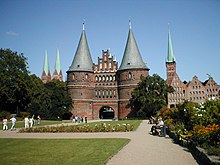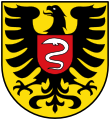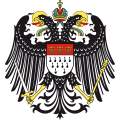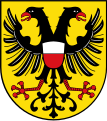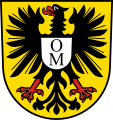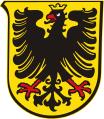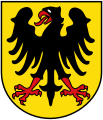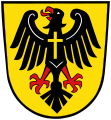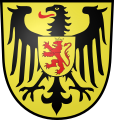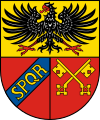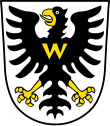Free and imperial cities
As free cities and imperial cities , those largely autonomous municipalities of the Holy Roman Empire that were represented in the city council of the Reichstag have been designated since the 15th century . The real imperial cities were not subordinate to any imperial prince , but directly to the emperor , so they were directly imperial . In contrast, the Free Cities still had a bishop as their nominal ruler , but they had rights of self-administration and privileges that made them de facto equal to the imperial cities. Therefore, over the course of time, the incorrect, popular collective term " free imperial city " emerged, although only a few cities were both free cities and imperial cities at the same time.
Imperial immediacy and freedom
The imperial cities were granted a number of freedoms and privileges from the status of imperial immediacy . They were largely autonomous internally and generally had their own lower and higher jurisdiction . In particular, the high judiciary put them on an equal footing with princes and differentiated them from the rural towns, which were subject to a sovereign . As imperial estates , the imperial cities also had special duties towards the emperor. So they had to pay their taxes directly to him and to make military successes on request .
The free cities included the episcopal cities of Basel , Strasbourg , Speyer , Worms , Mainz , Cologne and Regensburg . They had obtained their status through imperial or episcopal privileges similar to those of imperial cities. Differences existed, for example, in the fact that they did not make any military successes to the emperor except on crusades and did not have to pay any taxes to him.
The imperial bailiwick cities , such as Augsburg , represented an intermediate stage . They formally had the bishop as lord of the city. Originally, however, the bishops, as clergymen, were prevented from exercising certain secular rights of rule such as blood justice in person. They were therefore forced to delegate these activities to bailiffs . When some of these bailiwicks fell into the hands of the emperor or became imperial estates, the episcopal rights of rule came into conflict. The bailiff's rights formally derived from the bishop were in fact replaced by the bishop, because the bailiff, who was actually dependent on the bishop, was also his fiefdom.
The citizens had wrested their freedoms from their respective city lords, sometimes by force or through the use of financial means (pledging of sovereign rights such as the right to coin or the jurisdiction against loans). But while the secular sovereigns regained their power of rule over the cities from the late Middle Ages onwards, the emperors and bishops had fewer resources and reasons to do so, because they were elected to their office and could not bequeath their rights.
history
Beginnings
Originally, a distinction was made between imperial cities (or “royal cities” in the terminology at that time), which were directly imperial, and free cities, which had liberated themselves from an episcopal city regiment in the 13th and 14th centuries. The free cities were not obliged to pay taxes to the emperor and were not obliged to obey him. These included Lübeck , Utrecht , Cologne , Augsburg , Mainz (until 1462), Worms , Speyer , Strasbourg , Basel and Regensburg . For some, however, the bishop remained formally head of the city.
Imperial cities often owe their freedom to the extinction or loss of power of the sex of the respective sovereign. For example, Zurich became the imperial city of Zähringen in 1218 after the main line was extinguished , and Schaffhausen was raised to an imperial city by King Sigismund after the ostracism of Frederick IV of Austria in order to reduce his power base. Imperial cities often emerged from the founding of cities, which the Staufers , who were ousted in 1245 , had undertaken in the 12th and 13th centuries, or they were already owned by kings and emperors. For this reason, the number of imperial cities in the south-west of Germany as well as in Thuringia and Alsace, the former stronghold of the Staufers, was above average. There was a considerable number of relatively small country towns that could still acquire the status of an imperial town (such as Memmingen , Kaufbeuren , Ravensburg , Wangen im Allgäu , Pfullendorf , Buchau , Wimpfen , Bopfingen , Dinkelsbühl , Feuchtwangen , Rothenburg ob der Tauber , Schwäbisch Hall , Weil der Stadt , Mulhouse , Colmar , White Castle , Windheim , Hagenau , Schlettstadt , Annweiler ): on the one hand was the 12th and 13th centuries, the time of the founding cities, and on the other hand, it is after the fall of the Hohenstaufen succeeded no more territorial power, the former Subordinate property to their complete sovereignty. To enforce sovereignty over the former Hohenstaufen cities, which had already received many freedoms from the emperors, was only possible in a few cases. Since these cities only submitted to the elected Roman king or emperor, most of them acquired the status of imperial cities in the second half of the 13th century after the interregnum .
Moreover, in the course of time, many free cities were able to emancipate themselves from the rest of their spiritual city rule (others lost their free city status). Later the free cities took part in the Reichstag together with the imperial cities. The participating cities were summarized under the term "Free and Imperial Cities". From this formula, the term "free imperial city" was shortened.
Boom
After the Interregnum of 1273, the imperial cities and the free cities gained their new constitutional status over time and thus also seat and vote on the Reichstag . From 1489 they formed the Imperial City College and were regularly represented at the Imperial Diet. In the 15th and 16th centuries, the Association of Cities developed into an important institution for free and imperial cities in the Holy Roman Empire.
At that time, large cities such as Augsburg , Frankfurt am Main , Nuremberg , Schwäbisch Hall , Rothenburg and Ulm were able to expand their territory far beyond the city limits. The largest territorial expansion reached the imperial cities in southwest Germany, where there were no major principalities. The largest territorial expansion of all German imperial cities was reached by the imperial city of Nuremberg with an area of around 1,200 km², the largest of all city states the city and republic of Bern with an area of around 9,500 km².
In the course of time, numerous imperial cities were pledged by the royal rule to neighboring territorial rulers, such as the city of Nijmegen in 1247 to the Counts of Geldern , the city of Duisburg in 1290 to the Counts of Kleve or the city of Eger to the kings of Bohemia . Since the kingship usually could not raise enough funds to redeem the pledge sums, this could mean the end of imperial directness for the cities concerned. A distinction must be made here between whether the status of the imperial city was retained or whether the pledger took over ( mediatization ), which led to the loss of imperial immediacy. With regard to the imperial pledges, it should be noted that beginning with Charles V , who in his election surrender of July 3, 1519, expressly confirmed all regalia , privileges and pledges to the imperial princes , all subsequent emperors of the Holy Roman Empire assured the imperial princes in their electoral capitulations that they would be in To leave possession of the pledges. In the case of pledges, it was important to state the status of the facility, the modalities of the release of the pledge and the exemption from burdens and troubles of the citizens or restriction of their freedoms - for example in the case of Feuchtwangens in the deed of March 9, 1380 as supplements to the deed of pledge done by 1376.
In order to avoid the fate of mediatization, which would have led to the decline in the status of a territorial city, some of the affected cities single-handedly raised the deposit. Other cities were threatened by military action by neighboring powerful sovereigns. As a defense against this danger, for example, the Süddeutsche Städtebund was founded, which was supposed to prevent many Swabian cities from falling under the rule of the Counts of Württemberg .
Since the administrative reform under Emperor Charles V, the so-called rabbit council was introduced in many cities , which was formed by the nobility and the patricians and gradually made the assembly of estates ineffective.
Adaptation to the aristocratic and princely society
With the Peace of Westphalia in 1648, the bailiwick went to France via the Alsatian imperial cities , and France occupied Alsace in 1681 as part of the reunions .
In 1718 the area surrounding the imperial city of Zell am Harmersbach became independent from the city as the free imperial valley Harmersbach .
The rights guaranteed to the imperial cities and the other imperial estates in the Peace of Westphalia, such as the right of alliances and ambassadors, were also the foundation for a remarkable dynamic, especially in the field of foreign policy. In the 17th and 18th centuries, not only the representatives of the great powers could be found on the diplomatic floor, but also mayors, syndics and councilors.
For a long time, the imperial city of the early modern period was rated by historians as the lonely forerunner of the bourgeois world in the midst of the aristocratic environment, which repeatedly led to misunderstandings. The imperial cities generally had nothing to do with modern republics, but also with premodern republics such as Venice or the United Netherlands . The tendency to be recognized as a member of the aristocratic world determined the politics of many imperial cities, including Augsburg, Nuremberg, Cologne, Frankfurt, Bremen and even smaller municipalities like Schwäbisch Hall.
The conventional image of the supposedly gloomy conditions in the imperial cities of the 18th century also has its origin in the projection of economic rationality in the modern sense, which, however, did not determine the actions of councilors, guilds and citizens. Just as the description of German history in the early modern period as a history of decline corresponds to a historical misunderstanding, the negative assessment of the imperial cities in this epoch also follows partly anachronistic ideas (“decline”). Imperial cities provided the stage for many epoch-making historical processes (book printing, the Reformation, peace congresses). Up to the end of the 18th century imperial cities maintained their cultural, social and political position insofar as they, like the imperial counts and imperial knights , are understood as inferior members of the empire.
With the Reichsdeputationshauptschluss of 1803, 45 of the 51 still existing imperial cities were mediated and incorporated into neighboring principalities. Only Augsburg, Nuremberg, Frankfurt am Main, Bremen, Hamburg and Lübeck initially retained the status with reduced rights. Augsburg and Nuremberg were mediated by Bavaria in 1805/1806 . The other four remained independent.
Free cities after the end of the Holy Roman Empire
With the end of the Holy Roman Empire through its dissolution in 1806, the legal status of an imperial city with all its privileges and special rights also ceased. Frankfurt am Main, Bremen, Hamburg and Lübeck were nevertheless able to transfer parts of their old special rights into the newly formed state order after the Congress of Vienna in 1815. Even after the Congress of Vienna in 1815, they continued to be “free” cities with extensive autonomy and independence. Frankfurt am Main lost its independence in 1866 when it was annexed by Prussia ; Lübeck was also incorporated into Prussia in 1937 with the Greater Hamburg Act . The states of Bremen and Hamburg have retained their position as independent city-states, which dates back to imperial city traditions.
The status of Berlin as a separate country, however, goes back to the dissolution of the state of Prussia and the zoning after the Second World War . Similarly, the Austrian capital Vienna has been an independent federal state in the Republic of Austria since 1920/22 .
With the act of mediation of 1803, the Swiss imperial cities, which were legally separated from the Holy Roman Empire as early as 1648, were merged into the sovereign cantons newly founded from the respective city area and its subject area and exist as political units to this day. The cantons of Basel , Bern , Freiburg , Lucerne , Schaffhausen , Solothurn and Zurich can be traced back to former imperial cities ; the former imperial city of St. Gallen, which had no subject territory, was combined with various other territories to form the newly created canton of St. Gallen . At the same time, the previous cities became the political communities of the new cantons.
Gdansk was also called a free city when the city and its surroundings were under the sovereignty of the League of Nations from 1920 to 1939 .
List of free and imperial cities
The constitutional network of the Reich, which is based on customary rights and individual privileges and in which there are also contradicting individual findings, is difficult to generalize and structure. There are therefore no binding criteria as to whether and in what period a city is to be regarded as a free and / or imperial city; the number of cities is subject to greater fluctuations over time. In order to be a free imperial city in the fullest sense of the word at the beginning of the consolidation of the constitution of the empire at the end of the 15th century, a city had to be able to act relatively independently politically and possess imperial immediacy, the imperial estate in the form of participation in the court and imperial diets of the local assemblies of the cities or actively participate in their own city days from 1471, and it had to be available by and for the emperor / king and the empire, d. H. she was obliged to perform certain services. With the crystallization of the two benches of the city assembly, the structure of the free imperial cities took on a more concrete and definitive character; however, the fabric of the cities remained in flux. Bremen, for example, was only definitively confirmed as a free imperial city when the structure of the cities had already assumed an institutional character.
For the earlier times it is more difficult to determine criteria. The factual and legally secured imperial immediacy, for example through a royal letter of freedom, was a decisive criterion. The imperial immediacy could not only be granted but also withdrawn again; Cities could be pledged to a sovereign. The mention in the early, but unreliable imperial registers could be seen as a further indication of the temporary existence as an early free or imperial city, but is by no means sufficient on its own, as cities are also mentioned that actually never or in fact no longer belonged. Under the title Free and reichsstett the condition laid down in the Diet of Worms in 1521 recorded Reichsmatrikel 85 cities for example. Of these, however, some were never and others were only (still) insecure imperial cities; but Buchau and Bremen, which was not yet fully consolidated (imperial city certainly only since 1654/1731), were missing.
| Color legend | |
|---|---|
| Time of the end of the status as a free city / imperial city | |
| Before 1648 | |
| Peace of Westphalia (1648) | |
| 1648-1789 | |
| Napoleonic and Revolutionary Wars (1792-1815) | |
| Reichsdeputationshauptschluss (1803) | |
| End of the Holy Roman Empire of the German Nation (1806) | |
| After 1806 | |
| Persisting |
| city | Army register 1422 | Worms matriculation 1521 | Bank on the City Curia of the Reichstag | Imperial immediacy | Mediatization / end of the status of a free or imperial city | Comments on the end of the status | today's state |
|---|---|---|---|---|---|---|---|
| Aachen | Yes | Yes | Rheinische Städtebank | The residence of Charlemagne was an old royal property. The Charles Privilege, a letter of freedom dated January 8, 1166, granted Aachen city rights as well as market and minting rights and elevated it to the status of an imperial city. The status of the coronation city of the Roman-German rulers, as set out in the Golden Bull, underscored the imperial immediacy. | 1794 | conquered by France and annexed with the Peace of Campo Formio in 1797. | Germany |
| Bask | Yes | Yes | Swabian city bank | 1360. On December 3rd, Charles IV declared Aalen an imperial city. | 1803 | Reichsdeputationshauptschluss . Liked by Württemberg. | Germany |
| augsburg | Yes | Yes | Swabian city bank | 1276. On March 9, King Rudolf von Habsburg granted imperial immediacy with the privilege of having his own statute. | 1805 | mediated in the Peace of Pressburg . On March 4, 1806 fell to the Palatinate of Bavaria. | Germany |
| Basel | Yes | Yes | 1648 | Peace of Westphalia , de facto earlier. | Switzerland | ||
| Bern | Yes | No | 1218, by the Golden Handfeste von Bern (authenticity disputed), issued on April 15 in Frankfurt am Main by Emperor Friedrich II. | 1648 | Peace of Westphalia , de facto earlier. | Switzerland | |
| Biberach an der Riss | Yes | Yes | Swabian city bank | Elevated to a free imperial city in 1281 | 1803 | Reichsdeputationshauptschluss . Fallen to Baden (1806 to Württemberg). | Germany |
| Bisanz (Besançon) | No | Yes | Beginning in 1307, the city was directly imperial as a free imperial city de jure. | 1674 | conquered by France, annexed by France in the Peace of Nijmegen in 1678/79 . | France | |
| Bopfingen | Yes | Yes | Swabian city bank | 1241 beginning directly from the empire. | 1803 | Reichsdeputationshauptschluss . Fallen to Electoral Palatinate Bavaria (1810 to Württemberg). | Germany |
| Boppard | No | No | At least since the beginning of the 13th century, Boppard was a free imperial city. | 1309 | fallen with Oberwesel to Archbishopric Trier. | Germany | |
| Bremen | No | No | Rheinische Städtebank | 1186 free imperial city through the Gelnhauser privilege ; however, the city's status remained controversial. First invitation to a Reichstag in 1640, final confirmation of imperial immediacy in the Linz diploma of Emperor Ferdinand III. on June 1, 1646. | 1806 | 1806 Dissolution of the Holy Roman Empire, thus end of the imperial city status. Then occupied by France, annexed from 1811 to 1814, from 1815 a free city in the German Confederation. | Germany |
| Buchau | No | No | Swabian city bank | 13th Century. | 1803 | Reichsdeputationshauptschluss . Fallen to the Prince of Thurn and Taxis (1806 to Württemberg). | Germany |
| Buchhorn (Friedrichshafen) | Yes | Yes | Swabian city bank | In 1275 by King Rudolf v. Habsburg, together with Überlingen and Freiburg im Breisgau, were raised to the rank of imperial city. | 1803 | Reichsdeputationshauptschluss . Fallen to Electoral Palatinate Bavaria (1810 to Württemberg). | Germany |
| Colmar | Yes | Yes | Rheinische Städtebank | 1226 elevated to a free imperial city by a document from Frederick II. | 1679 | annexed by France in the peace of Nijmegen . | France |
| Dinkelsbühl | Yes | Yes | Swabian city bank | In 1241 in imperial tax list, achieved imperial city status in 1274. | 1803 | Reichsdeputationshauptschluss . Liked by Electoral Palatinate Bavaria. | Germany |
| Donauwörth | No | Yes | 1301 imperial immediately | 1607 | after an imperial execution carried out by the Duchy of Bavaria against imperial law as a pledge to Bavaria, finally after the imperial estate regained in 1705 in the Peace of Rastatt . | Germany | |
| Dortmund | Yes | Yes | Rheinische Städtebank | 1803 | Reichsdeputationshauptschluss . Liked by Nassau-Dillenburg. | Germany | |
| Duisburg | No | Yes | - | 1170 | 1290 | was pledged by King Rudolf von Habsburg to the Count of Kleve. | Germany |
| Düren | No | Yes | - | 1000 confirmed Emperor Otto III. Düren as a free imperial city | 1241 | Emperor Friedrich II pledged the city to the Count of Jülich. | Germany |
| Endingen am Kaiserstuhl | Yes | No | - | 1415 | 1428 | Germany | |
| Esslingen am Neckar | Yes | Yes | Swabian city bank | In 1181 Friedrich I. Barbarossa assigned his deputy in Esslingen political and legal tasks that affected the surrounding area and made Esslingen an imperial city at the latest. | 1803 | Reichsdeputationshauptschluss . Liked by Württemberg. | Germany |
| Wet cheeks | No | No | - | First mentioned in 1241 in the Reich tax article. Pledging to the Counts of Hohenlohe in 1324 and Counts of Oettingen in 1347, on April 23, 1376 from the city and bailiwick of the monastery by Emperor Charles IV for 5000 fl to his brother-in-law, the Burgrave of Nuremberg . On March 9th, 1380 additions to the document of 1376. On August 11th, 1406 further pledging by King Ruprecht with a serious expansion of the pledge area. Pledge no longer triggered. | 1803 | Reichsdeputationshauptschluss . Fallen to Prussia with Ansbach-Bayreuth . | Germany |
| Frankfurt am Main | Yes | Yes | Rheinische Städtebank | The city is an old royal possession; Charlemagne had a royal court built here. In 1219 the people of Frankfurt were first mentioned as citizens in a document. In 1220 the bailiff was abolished. The status of the electoral city of the Roman-German rulers, which was fixed in the golden bull in 1356, underlines the imperial immediacy. The last decisive step was the acquisition of the Reichsschultheissenamt and the royal forest in 1372 for 8800 fl. | 1806 | 1806 Dissolution of the Holy Roman Empire, thus end of imperial city status, mediation to the Principality of Aschaffenburg . From 1815 a free city again, finally annexed by Prussia in 1866. | Germany |
| Freiburg in Üechtland | Yes | No | In 1478 Freiburg received the status of a free imperial city after it was released from the sphere of influence of Savoy. | 1648 | Peace of Westphalia , de facto earlier. | Switzerland | |
| Friedberg | Yes | Yes | Rheinische Städtebank | In 1252 the planned town of Staufer became an imperial town. | 1803 | Pledged in 1455 to the Burggrafschaft Friedberg , 1803 Reichsdeputationshauptschluss . Fallen in Hessen-Darmstadt. | Germany |
| Gelnhausen | Yes | Yes | - | Founded in 1170 as an imperial city by Friedrich I. Barbarossa. | 1803 | Repeated pledging from 1326 onwards with the increasing influence of the pledges. From the 16th to the middle of the 18th century, protracted disputes about imperial city status before the Imperial Court of Justice. 1803 Reichsdeputationshauptschluss. To the last lien in Hessen-Kassel. | Germany |
| Gengenbach | No | Yes | Swabian city bank | 1366 | 1803 | Reichsdeputationshauptschluss . Liked bathing. | Germany |
| Giengen on the Brenz | Yes | Yes | Swabian city bank | 1391 acquisition of imperial freedom. | 1803 | Reichsdeputationshauptschluss . Liked by Württemberg. | Germany |
| Goslar | Yes | Yes | Rheinische Städtebank | 1290 | 1803 | Reichsdeputationshauptschluss . Fallen to Prussia. | Germany |
| Hagenau (Haguenau) | Yes | Yes | Rheinische Städtebank | At least since 1291 | 1679 | annexed by France in the peace of Nijmegen . | France |
| Hamburg | Yes | Yes | Rheinische Städtebank | In 1510 Hamburg was finally considered a Free Imperial City. | 1806 | 1806 Dissolution of the Holy Roman Empire, thus end of the imperial city status. Then occupied by France, annexed from 1811 to 1814, from 1815 a free city in the German Confederation. | Germany |
| Heilbronn | Yes | Yes | Swabian city bank | In 1371 the city became an imperial city on December 28th through a constitution by Emperor Charles IV. | 1803 | Reichsdeputationshauptschluss . Liked by Württemberg. | Germany |
| Herford | No | Yes | Late Middle Ages. In 1631 the status of a free imperial city was granted again in a process at the Reich Chamber of Commerce. | 1652 | annexed by Brandenburg-Prussia and its county Ravensberg slammed. | Germany | |
| Isny | Yes | Yes | Swabian city bank | In 1365 the Isnyer bought the rights of a free imperial city from their Vogtherren, the Truchsessen von Waldburg. | 1803 | Reichsdeputationshauptschluss . Fallen to the Count of Quadt (1806 to Württemberg). | Germany |
| Kaisersberg (Kaysersberg) | Yes | Yes | Rheinische Städtebank | In 1353 the city joined the League of Ten as a free imperial city. | 1679 | annexed by France in the peace of Nijmegen . | France |
| Kaiserslautern | No | No | - | In 1276 Rudolf von Habsburg raised it to the status of a free imperial city, already mentioned in 1260 as "civitas regia". | 1313/1314 | initially pledged, from 1357 onwards final loss of imperial immediacy. | Germany |
| Kaiserswerth | No | No | - | In 1181 Kaiserswerth became an imperial city. | 1273 | pledged to the Archbishop of Cologne. | Germany |
| Kaufbeuren | Yes | Yes | Swabian city bank | Privileged by Rudolf I of Habsburg on February 3, 1286. | 1803 | Reichsdeputationshauptschluss . Liked by Electoral Palatinate Bavaria. | Germany |
| Kempten | Yes | Yes | Swabian city bank | In 1289, by a privilege of King Rudolf von Habsburg, it was released from the abbot's sovereignty and placed directly under the king as a free imperial city. Definitive independence from the abbot only through the Great Purchase in 1525. | 1803 | Reichsdeputationshauptschluss . Liked by Electoral Palatinate Bavaria. | Germany |
| Cologne | Yes | Yes | Rheinische Städtebank | In 1288, the citizens of Cologne won independence from the Archbishop of Cologne in the Battle of Worringen. It was not until 1475 that it was officially elevated to the status of a free imperial city. | 1794 | conquered by France and annexed with the Peace of Campo Formio in 1797. | Germany |
| Constancy | Yes | Yes | 1192 and 1213, fight for an independent position from the bishop. Since the city of Konstanz can be shown to have paid half of its taxes to the emperor and half to the bishop, it may not be classified as a pure free city. | 1548 | after the defeat in the Schmalkaldic War in 1547 by Charles V annexed to Upper Austria. | Germany | |
| Landau in the Palatinate | No | Yes | Rheinische Städtebank | In 1291 Rudolf I of Habsburg raised the city to the rank of imperial city. | 1679 | annexed by France in the peace of Nijmegen . | Germany |
| Leutkirch | Yes | Yes | Swabian city bank | On January 29, 1293 Leutkirch were given the rights of the city of Lindau by King Adolf von Nassau with the same freedoms; thus it was raised to the status of an imperial city. | 1803 | Reichsdeputationshauptschluss . Fallen to Electoral Palatinate Bavaria (1810 to Württemberg). | Germany |
| Lindau | Yes | Yes | Swabian city bank | In 1274/1275 King Rudolf I confirmed the previously acquired town charter. Lindau now appears as an imperial city. | 1803 | Reichsdeputationshauptschluss . Fallen to the Prince of Bretzenheim (Austria 1804, Bavaria since 1806). | Germany |
| Lübeck | Yes | Yes | Rheinische Städtebank | In June 1226, Lübeck was granted imperial freedom from Emperor Friedrich II with the imperial freedom letter, and thus became a direct imperial city. | 1806 | 1806 Dissolution of the Holy Roman Empire, thus end of the imperial city status. Thereafter it continued to be a free city, annexed by France from 1811 to 1813, and in 1937 incorporated into the Prussian province of Schleswig-Holstein through the Greater Hamburg Act , resulting in the final loss of territorial independence. | Germany |
| Lucerne | Yes | No | In 1415, Lucerne received imperial freedom from Emperor Sigismund. | 1648 | Peace of Westphalia , de facto earlier. | Switzerland | |
| Markgröningen | No | No | - | In 1240 the Staufer city was raised to the status of a free imperial city with a former royal palace, but shortly afterwards it was already taken over by Württemberg, and in 1280 again directly under the empire. | 1336 | the Württemberg counts finally came into the possession of the city. | Germany |
| Memmingen | Yes | Yes | Swabian city bank | Declared a free imperial city by the Roman-German King Rudolf I of Habsburg in 1286. | 1803 | Reichsdeputationshauptschluss . Liked by Electoral Palatinate Bavaria. | Germany |
| Metz | Yes | Yes | In 1189 the city made itself independent of the bishop, between 1180 and 1210 Metz became an imperial city. | 1648 | in the Peace of Westphalia to France. | France | |
| Mulhouse | Yes | Yes | Rheinische Städtebank | In 1251 the city of Mühlhausen was given the right to appoint a mayor and thereby became a free imperial city, even if that office was pledged for a while in the 14th century. In the meantime the burgraviate had come to an end: in 1256 the citizens stormed the castle and razed it to the ground. Emperor Karl IV confirmed the imperial freedom of the city. | 1803 | Reichsdeputationshauptschluss . Fallen to Prussia. | Germany |
| Mulhouse (Mulhouse) | Yes | Yes | Declared a Free Imperial City in 1275 by the Roman-German King Rudolf I of Habsburg. | 1648 | Peace of Westphalia , de facto earlier. | France | |
| Munster im Gregorienthal (Munster) | Yes | Yes | Rheinische Städtebank | 1679 | annexed by France in the peace of Nijmegen . | France | |
| Neuchâtel on the Rhine | Yes | No | - | In 1219, Neuchâtel am Rhein was declared a free imperial city by Emperor Friedrich II. This was confirmed in 1274. | 1311 | the city came to the Habsburgs and thus became part of Upper Austria. | Germany |
| Neumarkt in the Upper Palatinate | No | No | - | In 1235 Emperor Friedrich II granted Neumarkt the same rights as Nuremberg in order to establish duty-free conditions between the two cities. | 1268 | From 1268 Neumarkt was pledged to the Wittelbachers, in 1329 the town finally fell to the Palatinate near Rhine in the Pavia house contract . | Germany |
| Nijmegen (Nijmegen) | No | No | - | In 1230 Nijmegen became a free imperial city under Henry VII | 1247 | pledged in funds. | Netherlands |
| Nordlingen | Yes | Yes | Swabian city bank | In 1215 Nördlingen received city rights from Emperor Friedrich II and became an imperial city. | 1803 | Reichsdeputationshauptschluss . Liked by Electoral Palatinate Bavaria. | Germany |
| Nordhausen | Yes | Yes | Rheinische Städtebank | On July 27, 1220, Nordhausen was raised to the status of a free imperial city by King and later Emperor Friedrich II. | 1803 | Reichsdeputationshauptschluss . Fallen to Prussia. | Germany |
| Nuremberg | Yes | Yes | Swabian city bank | In 1219, Emperor Friedrich II made Nuremberg an imperial city with the Great Letter of Freedom. | 1806 | occupied by French. The end of the Holy Roman Empire also sealed the city's independence; it was handed over to Bavaria in accordance with the Rhine Federation Act. | Germany |
| Oberehnheim (Obernai) | Yes | Yes | Rheinische Städtebank | 1240 | 1679 | annexed by France in the peace of Nijmegen . | France |
| Offenburg | No | Yes | Swabian city bank | In 1240 Offenburg became a free imperial city. | 1803 | Reichsdeputationshauptschluss . Liked bathing. | Germany |
| Oppenheim | No | No | - | After Oppenheim was returned to the Reich in 1147, it became a free imperial city in 1225 at the time of the Staufer Emperor Friedrich II. | 1398 | it finally belonged to the territory of the Electoral Palatinate, but was pledged to Kurmainz as early as the 14th century. | Germany |
| Pfullendorf | Yes | Yes | Swabian city bank | In 1220 Pfullendorf was raised to an imperial city by Emperor Friedrich II. | 1803 | Reichsdeputationshauptschluss . Liked bathing. | Germany |
| Ravensburg | Yes | Yes | Swabian city bank | In 1278 King Rudolf I of Habsburg confirmed the imperial city privileges of Ravensburg. | 1803 | Reichsdeputationshauptschluss . Fallen to Electoral Palatinate Bavaria (then to Württemberg in 1810). | Germany |
| regensburg | Yes | Yes | Swabian city bank | In 1207 and 1230, King Philip of Swabia and Emperor Friedrich II granted the city extensive privileges (Philippinum and Fridericianum), which subsequently enabled it to become a free city. As early as November 10, 1245, the citizens of Regensburg had Emperor Friedrich II confirm the city's right of self-government with the privilege of "appointing a mayor and council". After years of economic decline, a pro-Bavarian party succeeded in joining the city to the Duchy of Bavaria-Munich in 1485/86 . The urban imperial immediacy was restored in 1492. Regensburg lost its status as a free city and was just an ordinary imperial city. | 1803 | Reichsdeputationshauptschluss . Fallen to the Principality of Regensburg (1810 to Bavaria). | Germany |
| Reutlingen | Yes | Yes | Swabian city bank | To consolidate his claim to German rule, Emperor Friedrich II founded around 40 cities in southern Germany by granting existing settlements city rights by means of an imperial decree. Reutlingen was probably one of these, but there is no document. The appointment should have been made around 1230, as it must have preceded the beginning of the city fortifications. Reutlingen has had the right to do so since 1235 at the latest. | 1803 | Reichsdeputationshauptschluss . Liked by Württemberg. | Germany |
| Rheinfelden | Yes | Yes | - | 1225 | 1330 | Pledged to the Habsburgs, so it became part of Upper Austria. | Switzerland |
| Rosheim | Yes | Yes | Rheinische Städtebank | In 1303 Rosheim becomes an imperial city. | 1679 | annexed by France in the peace of Nijmegen . | France |
| Rothenburg ob der Tauber | Yes | Yes | Swabian city bank | Elevated to imperial city in 1274 by King Rudolf von Habsburg. | 1803 | Reichsdeputationshauptschluss . Liked by Electoral Palatinate Bavaria. | Germany |
| Rottweil | Yes | Yes | Swabian city bank | 1803 | Reichsdeputationshauptschluss . Liked by Württemberg. | Germany | |
| St. Gallen | No | Yes | In 1180 St. Gallen became an imperial city. | 1648 | Peace of Westphalia , de facto earlier. | Switzerland | |
| Schaffhausen | Yes | Yes | 1190 the city was under Emperor Heinrich VI. empire directly. | 1648 | Peace of Westphalia , de facto earlier. | Switzerland | |
| Schlettstadt (Sélestat) | Yes | Yes | Rheinische Städtebank | Friedrich II., Built a city wall in 1216 and granted the city the status of a free imperial city in a contract with the provost. A new treaty with King Rudolf von Habsburg assigned the rule of the city, which was previously divided between the empire and the provost, to the empire alone. | 1679 | annexed by France in the peace of Nijmegen . | France |
| Schwäbisch Gmünd | Yes | Yes | Swabian city bank | With the extinction of the Hohenstaufen dynasty, Gmünd gained imperial immediacy. | 1803 | Reichsdeputationshauptschluss . Liked by Württemberg. | Germany |
| Schwäbisch Hall | Yes | Yes | Swabian city bank | In 1280 the “Vienna arbitration” of King Rudolf von Habsburg ended a long conflict with the Limpurg taverns for city rule and enabled Schwäbisch Hall to achieve the status of an imperial city. | 1803 | Reichsdeputationshauptschluss . Liked by Württemberg. | Germany |
| Schweinfurt | Yes | Yes | Swabian city bank | Probably Emperor Friedrich I, Barbarossa had a new Civitas Imperii (imperial city) built using the existing royal property. In a letter from King Wilhelm of Holland of January 9, 1254, it is said that Schweinfurt was formerly an imperial city (... Swinforde, que olim imperii civitas fuerat). It remains unclear whether the city's rights were ever withdrawn or whether reference is only made to the destruction of the city. King Rudolf von Habsburg (1273–1308) confirmed Schweinfurt as an imperial city in his award of April 29, 1282. | 1803 | Reichsdeputationshauptschluss . Liked by Electoral Palatinate Bavaria. | Germany |
| Solothurn | No | No | In 1218, Solothurn, like Bern, was declared an imperial-free city after the death of the last childless Zähringer. | 1648 | Peace of Westphalia , de facto earlier. | Switzerland | |
| Speyer | Yes | Yes | Rheinische Städtebank | In a document from 1084, the population of Speyer first mentioned “cives”; the town charter that developed in the following years is referred to in another document from Henry IV from 1101 as “ius civile” or “ius civium”. On August 14, 1111, the "Great Letter of Freedom" was awarded by Heinrich V. This privilege was confirmed and expanded in 1182 by Friedrich Barbarossa and confirmed again in 1273 by King Rudolf I of Habsburg | 1792 | conquered by France and annexed with the Peace of Campo Formio in 1797. | Germany |
| Strasbourg | Yes | Yes | Rheinische Städtebank | Free imperial city beginning in 1262. | 1681 | Occupied by France and finally annexed in 1697 in the Peace of Rijswijk . | France |
| Tull (Toul) | Yes | Yes | 1648 | in the Peace of Westphalia to France. | France | ||
| Türkheim (Turckheim) | Yes | Yes | Rheinische Städtebank | In 1312 Türkheim became a free imperial city. | 1679 | annexed by France in the peace of Nijmegen . | France |
| Überlingen | Yes | Yes | Swabian city bank | At the end of the 14th century the city became a free imperial city. | 1803 | Reichsdeputationshauptschluss . Liked bathing. | Germany |
| Ulm | Yes | Yes | Swabian city bank | Elevated to a free imperial city in 1184. | 1803 | Reichsdeputationshauptschluss . Fallen to Electoral Palatinate Bavaria (1810 to Württemberg). | Germany |
| Verden | No | Yes | Verden became a free imperial city in the 15th century. | 1648 | in the Peace of Westphalia to Sweden. | Germany | |
| Cheeks | Yes | Yes | Swabian city bank | In 1217, Emperor Friedrich II determined in a document that the patronage of Wangen should remain in royal hands forever. At that time, Wangen apparently already had city rights. After the execution of the last Hohenstaufen Konradin in the so-called emperorless period (Interregnum), the city succeeded in asserting and systematically expanding its independence from the rule of the St. Gallen monastery. King Rudolf I of Habsburg finally sealed the status as a free imperial city in 1286. | 1803 | Reichsdeputationshauptschluss . Fallen to Electoral Palatinate Bavaria (1810 to Württemberg). | Germany |
| Because of the city | Yes | Yes | Swabian city bank | Weil became an imperial city around 1275, the exact year is unknown. | 1803 | Reichsdeputationshauptschluss . Liked by Württemberg. | Germany |
| Weißenburg im Nordgau | Yes | Yes | Swabian city bank | 1803 | Reichsdeputationshauptschluss . Liked by Electoral Palatinate Bavaria. | Germany | |
| Weißenburg (Wissembourg) | Yes | Yes | Rheinische Städtebank | In 1306 it was a free imperial city. | 1679 | annexed by France in the peace of Nijmegen . | France |
| Hosts (Verdun) | Yes | Yes | 1648 | in the Peace of Westphalia to France. | France | ||
| Weinberg | Yes | No | - | 1283 | 1417 | Germany | |
| Wetzlar | Yes | Yes | Rheinische Städtebank | In 1180, Emperor Friedrich I Barbarossa created an imperial bailiwick in the Wetzlar area and put the citizens of Wetzlar on an equal footing with the citizens of Frankfurt. Wetzlar also became an imperial city. | 1803 | Reichsdeputationshauptschluss . Fallen to the county of Wetzlar. | Germany |
| Wimpfen | Yes | Yes | Swabian city bank | Around 1300 the state of Wimpfens as an imperial city went hand in hand with the decline of the Staufer Empire. | 1803 | Reichsdeputationshauptschluss . Liked bathing. | Germany |
| Windsheim | Yes | Yes | Swabian city bank | 1248 Windsheim becomes a city / imperial city. | 1803 | Reichsdeputationshauptschluss . Liked by Electoral Palatinate Bavaria. | Germany |
| Winterthur | Yes | No | - | In 1415/17 the city was granted imperial freedom by the German King Sigismund , who was in opposition to the House of Habsburg. | 1442 | the city fell back to Habsburg, which in 1467 finally pledged it to the city of Zurich. | Switzerland |
| Worms | Yes | Yes | Rheinische Städtebank | In 1184, Emperor Friedrich Barbarossa granted the city extensive freedoms, which can be seen as the foundation of the imperial city. The 12th century was marked by the beginning of the dispute between the bishop and the city council over de facto rule over the city - a conflict that would last into the 16th century. | 1792 | conquered by France and annexed with the Peace of Campo Formio in 1797. | Germany |
| Zell am Harmersbach | No | Yes | Swabian city bank | Zell became an imperial city at the end of the 14th century. However, it constantly had to defend itself against attempts by the Austrian Ortenau to incorporate the city into their territory. | 1803 | Reichsdeputationshauptschluss . Liked bathing. | Germany |
| train | No | No | In 1400, on June 24th, King Wenzel granted the city of Zug a high degree of jurisdiction, the ban on blood, over the city and its offices. With the granting of imperial freedom by King Sigismund in 1415, Zug became independent and all Habsburg claims were extinguished. | 1648 | Peace of Westphalia , de facto earlier | Switzerland | |
| Zurich | Yes | No | In 1218 Greater and Fraumünster became directly part of the empire, in 1219 Frederick II implicitly formulated the imperial freedom of the city, and in 1265 Richard of Cornwall also expressly confirmed imperial freedom of citizenship. | 1648 | Peace of Westphalia , de facto earlier | Switzerland |
- Also mentioned in the army register of 1422
- Aschersleben , Breisach , Diessenhofen , Frauenfeld , Freiburg im Breisgau , Halberstadt , Kenzingen , Lauffenberg , Mainz , Quedlinburg , Rappoltsweiler (Ribeauvillé), Säckingen , Trier , Waldshut
- Also mentioned in the Worms Reich register
- Brakel , Kamerich (Cambrai), Danzig , Elbing , Göttingen , Lemgo , Saarburg (Sarrebourg), Soest , Warburg , Wesel
- Other former imperial cities
Kampen , Deventer and Zwolle were given the right to call themselves imperial cities by Emperor Maximilian on October 1, 1495 at the Reichstag in Worms. Other cities, such as Groningen , called themselves a free imperial city , even if they never officially achieved this status despite a possible independence as a free city. Groningen even made its claim clear in the city arms. The small district of Kessenich is sometimes called the "free imperial city"; However, it is more a question of imperial rule, a "vrije rijksheerlijkheid", probably comparable, for example, with the Ingelheimer Grund . In other sources, such as the Cologne Chronicle , the status of other Hanseatic cities is assigned; however, they are probably just free or largely autonomous cities.
- Short-term imperial cities 12. – 15. Century
|
heraldry
Since they only had the king or the emperor as ruler , many imperial cities referred to him in their symbolic representation when training their heraldry (or later) by including the eagle as the heraldic animal of the Roman-German ruler in their coat of arms, either as a direct takeover (e.g. near Aachen), in different colors (Frankfurt) or as an element in the coat of arms (Nuremberg). Some imperial cities announced their status at their city gates, among other things; For example, at the Eschenheimer Turm in Frankfurt you can still find the imperial double-headed eagle in the city center and the single-headed Frankfurt eagle out of the city. Among the episcopal cities that were able to tear themselves away from their spiritual master as free cities or were later recognized by the Roman-German rulers as imperial directors, there are some that bear the eagle in their coat of arms.
- City arms with eagle
Compilation of various coats of arms of imperial cities in Johann Siebmacher's coat of arms book (1605):
See also
literature
Overall representations
- Klaus Gerteis : The German Cities in the Early Modern Age. On the prehistory of the 'bourgeois world' . Scientific Book Society, Darmstadt 1986, p. 65-84, 176-182 . Excerpts from the print edition ( Memento from January 24, 2013 in the Internet Archive )
- Gustav Wilhelm Hugo: The mediation of the German imperial cities . G. Braun, Karlsruhe 1838 ( google.de ).
- Paul-Joachim Heinig : Imperial cities, free cities and royalty 1389–1450. A contribution to the German constitutional history (= publications of the Institute for European History, Mainz. Vol. 108 = contributions to the social and constitutional history of the Old Empire. Vol. 3). Steiner, Wiesbaden 1983, ISBN 3-515-03531-1 .
- André Krischer: Imperial cities in the princely society. Political use of symbols in the early modern period. Scientific Book Society, Darmstadt 2006, ISBN 3-534-19885-9 .
- Götz Landwehr : The pledging of the German imperial cities in the Middle Ages, research on German legal history. Volume 5, Cologne 1967.
- Thomas Lau , Helge Wittmann (Ed.): Emperor, Empire and Imperial City in Interaction. Michael Imhof Verlag, Petersberg 2016.
- Peter Moraw : Imperial city, empire and royalty in the late Middle Ages. In: Journal for Historical Research. 6, 1979, pp. 385-424.
- Johann Jacob Moser : From the Reichs-Stättischen regimental constitution. According to the imperial laws and imperial origins, as well as from the German state law lessons and personal experience . Mezler, Frankfurt / Leipzig 1772 (digitized version)
- Helmut Neuhaus : The Empire in the Early Modern Age (= Encyclopedia of German History. Volume 42). Oldenbourg, Munich 2003, p. 34f.
- Richard Schmidt : German imperial cities. Hirmer, Munich 1957.
- Joachim Schneider: The imperial cities. In: Matthias Puhle , Claus-Peter Hasse (ed.): Holy Roman Empire of the German Nation 962 to 1806. From Otto the Great to the end of the Middle Ages. Essays. 29. Exhibition of the Council of Europe in Magdeburg and Berlin and state exhibition Saxony-Anhalt. Dresden 2006, pp. 410-423.
Regional representations
- Urs Hafner: Republic in conflict. Swabian imperial cities and bourgeois politics in the early modern period. Bibliotheca Academica, Tübingen 2001, ISBN 3-928471-36-8 .
- Daniel Hohrath , Gebhard Weig, Michael Wettengel (eds.): The end of imperial city freedom 1802. On the transition of Swabian imperial cities from emperor to sovereign. Accompanying volume to the exhibition "Kronenwechsel" - the end of imperial city freedom 1802 (= research on the history of the city of Ulm. Documentation series . Volume 12). Kohlhammer Verlag , Stuttgart 2002, ISBN 3-17-017603-X .
- Wolfgang Wüst : Communication and Alliance. On the role of Upper German imperial cities in the peasant unrest in 1524/25. In: Elmar L. Kuhn (Ed.): The Peasants' War in Oberschwaben . Bibliotheca Academica, Tübingen 2000, ISBN 3-928471-28-7 , pp. 445-467.
Web links
- swell
Remarks
- ↑ Registration area in the Nürnberger Künstlerlexikon , accessed on April 26, 2020
- ^ Election capitulation of Charles V (§ 4), In: Karl Zeumer (editor): Collection of sources for the history of the German Reich constitution in the Middle Ages and modern times. Tübingen 1913, No. 180.
- ^ Kai-Michael Hingst: Reich pledge. In: Lexicon of the Middle Ages . 7, 1995, col. 633.
- ↑ MGH DD FI, 2, No. 502 .
- ^ RI VIII n.3443 .
- ^ RI VI n.530 .
- ^ RI V, 4 n.154 .
- ^ Heinrich Gottfried Philipp Gengler: Codex juris municipalis Germaniae medii aevi. F. Enke, 1863, p. 256. ( limited preview in Google book search)
- ↑ MGH DD FI, 4 No. 955 .
- ↑ Gengenbach: Zähringer foundation - imperial city - Benedictine abbey. In: Badische Heimat. 30. Vol. 2, 1950, p. 16ff.
- ↑ a b RI VI n.2440
- ^ RI VIII n.5012
- ^ RI VI n.586
- ↑ RI VI n. 2231
- ↑ In and around Leutkirch, pictures from twelve centuries. Large district town Leutkirch im Allgäu 1993, p. 16ff.
- ^ RI VI n.190
- ^ RI VI n.284
- ^ RI VI n.337
- ^ RI V n.1636
- ↑ RI XI n.1616 , RI XI n.1618 , 1619 , 1620
- ^ RI VI n. 1966
- ↑ RI V n. 4555 , RI V n. 4556
- ↑ Charles de Lasablière: Histoire de la ville de Mulhouse jusqu'à sa réunion à la France en 1798 ... J. R. Riesler, Chantilly 1856, p. 36
- ^ RI VI n.125 .
- ↑ RI V n.840
- ↑ RI V n. 3849f
- ^ RI V n.1069
- ↑ RI IV, 1, 2 n.429 .
- ^ RI V n.1136 .
- ^ RI V n.142 .
- ^ RI V n.1825 .
- ^ RI VI n.160 .
- ^ RI VI n.1162
- ^ The great freedom letter of Henry V ( Memento from December 16, 2009 in the Internet Archive )
- ↑ RI V n.892
- ^ RI VI n. 1962
- ↑ RI IV, 2 n.2539
- ↑ RI XI n.1758 .
- ^ RI XI n.2703
- ↑ Werkgroep Tentoonstellingen ( Memento from May 11, 2012 in the Internet Archive ) In: levendestadsgeschiedeniszwolle.nl
- ↑ The Hanseatic League. In: universos-mercatores-de-hansa-theutonicorum.de. Retrieved January 2, 2015 .
- ↑ Cities and towns in the Netherlands: Nijmegen / Nimwegen. In: Niederlande-wegweiser.de. Retrieved January 2, 2015 .
- ^ Gau-Odernheim, tour
- ↑ cf. Walter Kleindel: Austria Chronicle. History and culture data . Ueberreuter, Vienna / Heidelberg 1978, pp. 56, 58.

